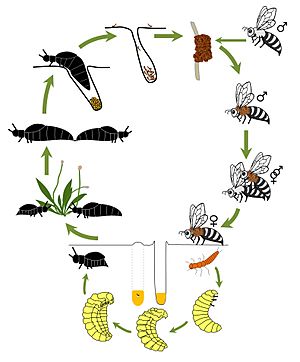Meloe franciscanus facts for kids
Quick facts for kids Meloe franciscanus |
|
|---|---|
| Scientific classification | |
| Genus: |
Meloe
|
| Species: |
franciscanus
|
Meloe franciscanus is a type of blister beetle that lives in the deserts of the southwestern United States. These beetles are known for their interesting life cycle. Their young, called larvae, are parasites. This means they live off other creatures. They eat the larvae of bees and also consume the food the bees collect.
Where They Live: Desert Homes
Meloe franciscanus beetles are found only in the southwestern United States. This is called being endemic. They live among sand dunes in desert areas. Their home includes patches of plants surrounded by bare sand.
One important plant for them is Astragalus lentiginosus. Adult beetles, which cannot fly, eat this plant. This plant also provides nectar for the bees that the beetles depend on. Female beetles usually lay their eggs at the base of these plant patches.
Life Cycle: A Clever Trick
The larvae of Meloe franciscanus use a very clever trick to survive. They pretend to be something they are not!
First, the adult female beetle lays her eggs underground. She lays many eggs together, often around 761 eggs in one group. When the beetle larvae hatch, they come out of the ground. They climb up plants one after another. Then, they gather together to form a tight ball in a high spot on the plant.
Next, these larvae release a special smell. This smell is very similar to the pheromones (chemical signals) that a female bee sends out to attract a male bee. A male digger bee smells this and thinks the ball of larvae is a female bee. He tries to mate with the ball of larvae.
When the male bee touches the larvae, they quickly cling to him. Later, when this male bee finds a real female bee and mates with her, the beetle larvae transfer to the female bee. The female bee then carries these tiny beetle larvae to her own nest.
Once inside the bee's nest, the beetle larvae let go of the bee. They make themselves at home! They eat the pollen and nectar that the female bee collected for her own young. They also eat the bee's eggs and young larvae.
Scientists have studied which digger bee species are tricked by these beetles. In Oregon and the Mojave Desert, the bees are Habropoda pallida and Habropoda miserabilis. Researchers found that the newly hatched beetle larvae (called triungulins) climb to different heights on plants. They do this depending on how high the male bees in that area fly when looking for mates.
See also
 In Spanish: franciscanus Meloe franciscanus para niños
In Spanish: franciscanus Meloe franciscanus para niños


